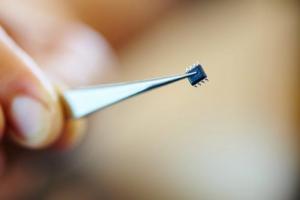Breeding mantises is another step beyond just keeping them! This can be very interesting and educational, but at the same time it is much more difficult than simply keeping one or more individuals as pets. To breed, you need one or more opposite-sex pairs that have reached the adult stage at about the same time. Then you need to make sure that the female does not eat the male before mating occurs. Once the fertilized eggs are laid in the ootheca, you will need to take care of them to ensure that healthy nymphs hatch.
The difficulty of breeding and rearing nymphs varies greatly between species. Some species are relatively easy to propagate, while others can only be propagated by very experienced terrarium keepers. In the section with descriptions of species, you can read about the difficulties and characteristics of specific species.
Getting a pair (male and female)
To have offspring, you need a male and a female. Female stick insects, aphids, and some other insects are capable of producing viable eggs without the participation of a male (parthenogenesis), but almost all praying mantises require fertilization for the eggs to develop. You can read how to determine gender.
To ensure the possibility of mating, the male and female must molt into adults at approximately the same time. An old male is often unable to mate properly with a female. For most species, getting a mate within a few weeks of each other gives them the opportunity to mate, but for others it doesn't work. In some species, such as Hymenopus coronatus, a big difference in the development of males and females. Males and females from the same ooteca mature into different terms, sometimes the difference is months. The male will already die of old age before the female reaches maturity.
How to connect a pair
For most species, you can follow the following "recipe" to ensure cannibal mating.
- The male and female must have reached the adult stage at least 2 weeks ago.
- Both partners, especially the female, must be very well fed.
- Place the partners in a very large terrarium, the largest you can find.
- Make sure that the female does not collide with the male, but he sees her.
- Give the female a large food item, such as a cockroach.
- Don't bother them.
- Observe whether the female behaves aggressively, how she turns, moving towards the male, or whether she attacks him. See if the male is trying to escape or fly away. If any of these things happen, remove the male and try again the next day.
- Once a male has mounted a female, it may take many hours before he begins to mate. Just leave them, don't bother them or feed them.
- When the male gets off the female, remove him from the terrarium.
For species that are not (very) prone to cannibalism, such as Phyllocrania paradoxa, you don't need to do anything other than place partners in the same terrarium.
You cannot know for sure whether the female has been impregnated. She will lay oothecae even if she has not mated. Once the female's body has processed the male's spermatophore, you may find a small white spermatophore released from her body a few hours to a day after mating. If you see this, the mating was probably successful, but even then you can't be 100% sure.
Once a female has mated, she will remain fertilized for the rest of her life! It is prudent to mate her again with a male if she has produced a lot of edema (say 4-5 pieces).
Preservation of a living male
When mating, the male may be eaten by the female. This can happen before, during or after the process. This is something you'll have to deal with, especially if you're keeping species that are prone to cannibalism, but there are ways to reduce the chance of the male dying.
- Give the female REALLY plenty of food before introducing the male.
- Make the female eat the prey when the male appears.
- Place the pair in a large container or even a room so the male can escape. They usually see the female's plans.
- Make sure both partners are calm and not stressed by your manipulation of them.
- Place the male in the evening rather than in the morning or afternoon.
If you breed praying mantises this way, even the most cannibalistic species will kill no more than 10% of your males. And even when the male is killed during mating, the female can still become fertilized.
Demonstration video on how to prevent an aggressive female from eating a male:
The praying mantis is a fascinating insect widely distributed throughout the world. He is an excellent choice as a pet. Even people who don't like bugs can be convinced to enjoy the antics of the praying mantis. For example, did you know that it turns its head to look over its shoulder (in fact, it is the only insect that can do this!)? Mantises come in different colors, such as pink like a flower (orchid mantis - Hymenopus coronatus) and white, although most are brown or green. The type of mantis you can keep depends on where you live and whether you got it off the street or from an exotic pet store. Raising a praying mantis is quite easy and a lot of fun. You will probably learn much more about this unique and interesting insect, just watching his daily antics.
Steps
Part 1
Find the praying mantis- Look in areas where there are lots of green bushes, crickets and butterflies. These are some of the praying mantis' favorite foods.
- Look carefully. These small insects are masters of camouflage. Most of them are long and green. Some may be thick and gray or even have a pinkish tint. Some look like flowers, but these species are most often found in Africa and Asia. Try to imagine the praying mantis pretending to be part of a plant, and this will make it a little easier to find.
-
Purchase a container for the praying mantis. Buy a small container and place your praying mantis in it as soon as you find one. The container does not need to be very large - a 15 x 15 cm square container should be suitable for most mantises. The container should be well ventilated and preferably made of mesh or chicken wire so that both the mantis and its prey have something to cling to. It should also be protected from above. Never use a container that has contained chemicals.
Catch a praying mantis. You probably won't need gloves if you don't mind touching insects. Simply place an open container in front of the praying mantis. Use a twig or your hand to move the insect into the container if you are comfortable with this. Soon the mantis should willingly enter the container. Cover the top of it, as mantises are smart and will use any opportunity to escape.
Buy a praying mantis. If you can't find a praying mantis, or if they simply don't live in your area, visit your local pet store and ask if they can get a specific praying mantis for you. It can give you more ample opportunities in choosing a species - it all depends on the legislation of your country regarding the import of insects and keeping them as pets.
Part 2
Prepare a home for the praying mantisPart 3
Feed the praying mantis correctly-
Feed the praying mantis properly. The nutritional requirements of a praying mantis vary depending on their growth stage, although in general they don't need a lot of food.
Sprinkle water around the praying mantis to provide it with hydration. Take a spray bottle and spray the bars of the mantis cage. If the cage is not wire, then simply pour water into the bottle cap and let the mantis drink from it. Remember, praying mantises like to hang from something, so stick a stick or something near the drinker.
Remove leftover food from the mantis's home. Praying mantises are not the tidiest eaters and will leave behind debris after feeding, including legs, wings, tough parts that insects don't like, etc., all of which need to be cleaned up daily. Allowing debris to accumulate can stress your pet, making it unable to survive in a built environment.
- When cleaning up leftover food, also remove the mantis feces (in the form of pellets).
Part 4
Keep your praying mantis properlyPart 5
Handle the praying mantis correctly-
Handle the insect with care. The praying mantis is a fragile insect, no matter how strong it appears. Be careful when lifting it, as there is some risk of crushing the insect with overly enthusiastic squeezing. In addition, the praying mantis can defend itself by stabbing its legs into its host. This will probably surprise you more than it will cause pain, but for the insect it is certainly a stressful situation in which it may become defensive. There is a solution - extend your palm, finger or upper arm, and let the insect rise at its own pace. Be patient!
- When cleaning a praying mantis' cage, don't be afraid to pick it up. If you want, do this with gloves.
-
Don't be afraid to play with and pet your praying mantis. Some mantises, by the way, love it when their owners stroke their abdomen (the thorax, to be more precise, the place where the limbs are attached to the body).
Part 6
Know how to breed praying mantises- Some online stores sell a bag of eggs that can be placed in the garden to hatch the larvae. This allows the local population of mantises to increase, the number of insects to decrease, and the opportunity to observe them in their natural environment.
- Mantises have a very fragile egg shell, so be very careful.
- Never touch a praying mantis when it is molting!
- Mantises are harmless to humans, although they are terrible enemies for other insects.
- Use a fluorescent light over the vivarium if you want to see your praying mantis at night. This will also provide light to any living plants you may be growing - they will appreciate it.
- With proper care, praying mantises can live up to one and a half years.
- Always handle any insects carefully and wash your hands after handling their cages and accessories.
- Do not pick up an animal unless you are sure it will not bite or scratch you.
- It may be preferable to simply observe praying mantises in the wild rather than keeping them in captivity. They are so nice to look at. They will look at you the same way. A visit from a praying mantis is good luck. Killing a praying mantis can bring you bad luck.
- Contrary to popular belief, praying mantises are not endangered. If you kill one, you won't have any problems with the law. But that doesn't mean you should do it!
- It is better to buy a praying mantis at a pet store. A caught wild mantis can suffer severe stress, which can lead to the death of the insect.
- Buy a container that is ventilated at the top and bottom.
- Always handle any animals with care!
-
Find the praying mantis. The praying mantis is found in many parts of the world; some species were introduced to Russia and the CIS countries and have since begun to adapt to new conditions. If you know they are in your area, try finding a wild mantis. Praying mantises are typically about 7–8 cm long, mostly brown or green in color, and look just like sticks and leaves, making them blend in well with their surroundings.
The domestic praying mantis is a very unusual pet to keep at home. This insect is graceful, quick-witted and very interesting to watch. In addition, it is a dangerous predator for insects living in your home, such as cockroaches and crickets, because mantises belong to the class of carnivorous insects.
Most mantises live on continents with tropical climates, but sometimes you can find some representatives in the northern parts of the earth. Grasshoppers and stick insects are related to them. All these types of insects, including praying mantises, are subject to several stages of metamorphosis, which transform them into adults. The domestic praying mantis is a rare pet even in the homes of extravagant breeders, but today we will talk about it. So, let's highlight a few main points that should be considered when keeping a praying mantis at home.
A little about the insect
An adult praying mantis can be quite large in size - his length may be ten and more centimeters.
The color of this insect can be yellow, green, light brown or other, V dependencies from environment a habitat. Having ability To mimicry from nature, mantis Maybe merge with branches, plants And stones having a similar color, and therefore it will be very difficult to notice.
He has a triangular, highly mobile head, which he can rotate 180 degrees. The front legs are well developed with sharp spines, with which it grabs its prey and holds it while eating. The praying mantis also has wings, but it flies very poorly, so most often it sits motionless in one place, waiting for prey.
The lifespan of a domestic praying mantis is about two months, but some species, according to some sources, can live for about a year.
Temperature
Since insects are tropical inhabitants, accordingly, it is necessary to keep a praying mantis at home in temperature conditions from 20 to 25°C, while also observing the required humidity regime. Maintaining humidity in the praying mantis cage is not difficult, just spray water over the cage once a day, this will be enough.
How does a domestic praying mantis feed?
What to feed a praying mantis at home? Such pets prefer aphids, flies, and other insects of suitable size. Young individuals grow very quickly, provided that the owner feeds them well.

Many representatives of mantises can show aggression towards their relatives, so cannibalism is quite possible, especially if there is a significant difference in size between individuals. Pet praying mantises can also consume insects that are the same size, or perhaps even larger than themselves.
Praying mantises do not drink water in most cases; however, a container of water should be placed where they are kept. This will also serve as a source of moisture to maintain the desired microclimate. If there is no container, spraying water to provide humidity will be a necessary condition.
Living conditions
During the stages of its development, the praying mantis tends to shed its skin, thus increasing in size. For individuals that have just been born, a small container will be an excellent home, but for teenagers you can use a jar or something similar in size. The temporary housing of young mantises should be covered with film, after making a hole in it for feeding. A necessary condition is the presence of branches in a container, which should be exactly three times larger in size than the young growth.

Features of reproduction
When kept at home, a young mantis has almost no gender difference, but adult individuals can be easily recognized due to the fact that males have eight lobes on the abdomen, but females have only six. Before insects begin to mate, they must be fed with a large amount of food, while being separated from each other. To prevent the male from becoming food for the female, a container is needed large sizes, where the breeding process will take place. The whole action may take several minutes or days, but the presence of food is required. After mating is over, the male is separated from the female.

A female can produce eggs ranging from 30 to 300 eggs. The larvae will be born in an interval of 3 to 6 months, but they may not all hatch at once.
The main nuance for keeping praying mantises at home is the presence of a large container for their habitat, which must necessarily contain live food, as well as the opportunity for its inhabitants to hide. By observing these requirements, cannibalism will be excluded, however, after the insects have moulted several times, they must be seated.
If you want to get yourself an unusual insect, then a domestic praying mantis is ideal. This insect is undemanding in maintenance and does not take up much space. Such a pet can be caught in the wild or purchased at a pet store.
And if you haven’t yet chosen a pet to match yours, pay attention to the terrible one - the hero of Hollywood horror films or his eternal enemy -.
Did you like the article? Take it to your wall and support the project!
The size of which depends on the size of the praying mantis, but all terrariums must have good ventilation, with transparent walls (2-3 walls must be completely transparent), a mesh must be glued to the walls and lid. At the bottom of the terrarium, it is advisable to pour 2–3 cm of soil ( coconut flakes), retains moisture in the terrarium, this is especially important for larvae that will moult. If the soil is not placed in the terrarium, then it should be lightly moistened with water from a spray bottle once every two days. It is important that during the day all the water evaporates from the walls of the terrarium. It’s good if the terrarium has branches that connect the bottom to the lid, so it will be more comfortable for the praying mantis to go down and up the branches. The praying mantis feels comfortable when room temperature 22–26°C and humidity 40–60%. Mantises do not need additional lighting, but if you install an incandescent lamp or other lamp, this will not harm the mantis, the main thing is that it has the opportunity to crawl away from the lamp to a certain distance, where the lamp does not heat up so much. Do not leave the terrarium with the praying mantis on direct sunlight, this can lead to overheating and dehydration of the mantis. Under no circumstances use an electric mosquito fumigator in the room where you have a praying mantis!
Feeding
It is necessary to feed the praying mantis until it is full. A hungry mantis has a flat, leaf-shaped abdomen (photo 1). When the mantis is well-fed, its abdomen is swollen and resembles a swollen tree bud (photo 2). When feeding a praying mantis, try not to allow any uneaten insects to remain in the terrarium, which could interfere with the praying mantis' molting process. Under no circumstances feed the mantises with red cockroaches caught at work, in the cafeteria or at home, these cockroaches are poisoned and the mantis will die from such food. Mantises can be fed grasshoppers, flies and other insects collected from the wild. Adult females can cope with any insect, and can also eat a small frog (photo 3), a lizard or a newborn mouse.
Photo 1. Hungry mantis









